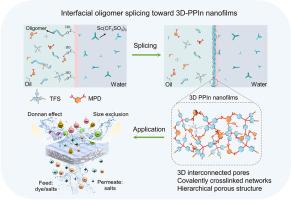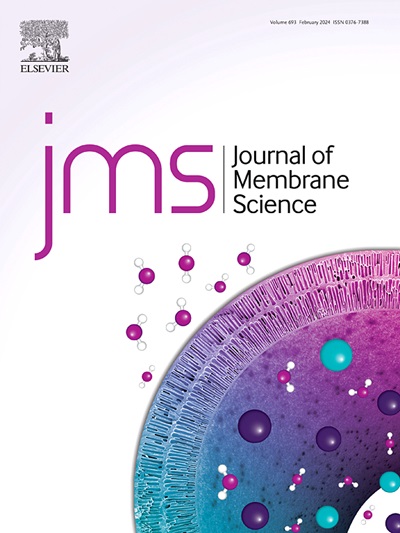Interfacial oligomer splicing toward 3D silicon-centered polyimine nanofilm for rapid molecule/ion differentiation
IF 8.4
1区 工程技术
Q1 ENGINEERING, CHEMICAL
引用次数: 0
Abstract
3D porous organic polymers —renowned for rich interpenetrated, hierarchical pores and exceptional structural durability— showcase the potential for precise membrane-based separations. However, the challenge lies in processing these chemically stable polymers into a selective thin film under mild conditions. Herein, an interfacial oligomer splicing (IOS) approach via Schiff-base reactions is presented to create 3D silicon-centered porous polyimine (PPIn) nanofilms. The pre-synthesized oligomers from 4,4′,4″,4‴-silanetetrayltetrabenzaldehyde (TFS) and m-phenylenediamine (MPD) with high steric hindrance and hydrophobic character are precisely confined at the oil boundary, initiating IOS to yield an amorphous nanofilm on a Kevlar hydrogel surface. These silicon-centered 3D nanofilms exhibited an exceptional thermal and mechanical stability, while offering abundant low-resistance transport nanochannels. The nanofilm backbone, composed of rigid nonplanar aromatic skeleton and robust imine linkage, contributed to open and interpenetrated selective nanochannels, corroborated by both experimental and simulation and results. It was shown that 83-nm-thick PPIn nanofilms grown on the hydrogel achieved high-efficient molecule/ion differentiation, evident in excellent dye retention (>99.0 %), high NaCl permeation (92.8 %), and remarkable water permeability (74.3 L m−2 h−1 bar−1). This study establishes an innovative IOS approach for fabricating silicon-centered 3D-POP membranes and underscores their potential for efficient molecule/ion differentiation.

面向三维硅中心聚酰亚胺纳米薄膜的界面低聚物拼接,实现分子/离子快速分化
三维多孔有机聚合物因其丰富的互穿、分层孔隙和优异的结构耐久性而闻名于世,展示了基于膜的精确分离的潜力。然而,将这些化学性质稳定的聚合物在温和的条件下加工成选择性薄膜是一项挑战。本文介绍了一种通过席夫碱反应的界面低聚物拼接(IOS)方法,用于制造三维硅中心多孔聚酰亚胺(PPIn)纳米薄膜。预先合成的 4,4′,4″,4‴-硅四乙基四苯甲醛(TFS)和间苯二胺(MPD)低聚物具有高立体阻碍和疏水特性,它们被精确地限制在油边界上,启动 IOS 在 Kevlar 水凝胶表面生成无定形纳米薄膜。这些以硅为中心的三维纳米薄膜具有优异的热稳定性和机械稳定性,同时提供了丰富的低阻力传输纳米通道。纳米薄膜骨架由刚性非平面芳香族骨架和坚固的亚胺连接组成,有助于形成开放和相互渗透的选择性纳米通道,实验和模拟结果均证实了这一点。实验和模拟结果表明,在水凝胶上生长的 83 纳米厚的 PPIn 纳米薄膜实现了高效的分子/离子分化,表现为出色的染料保留率(99.0%)、高氯化钠渗透率(92.8%)和显著的透水性(74.3 L m-2 h-1 bar-1)。这项研究确立了一种创新的 IOS 方法,用于制造以硅为中心的 3D-POP 膜,并强调了它们在高效分子/离子分化方面的潜力。
本文章由计算机程序翻译,如有差异,请以英文原文为准。
求助全文
约1分钟内获得全文
求助全文
来源期刊

Journal of Membrane Science
工程技术-高分子科学
CiteScore
17.10
自引率
17.90%
发文量
1031
审稿时长
2.5 months
期刊介绍:
The Journal of Membrane Science is a publication that focuses on membrane systems and is aimed at academic and industrial chemists, chemical engineers, materials scientists, and membranologists. It publishes original research and reviews on various aspects of membrane transport, membrane formation/structure, fouling, module/process design, and processes/applications. The journal primarily focuses on the structure, function, and performance of non-biological membranes but also includes papers that relate to biological membranes. The Journal of Membrane Science publishes Full Text Papers, State-of-the-Art Reviews, Letters to the Editor, and Perspectives.
 求助内容:
求助内容: 应助结果提醒方式:
应助结果提醒方式:


